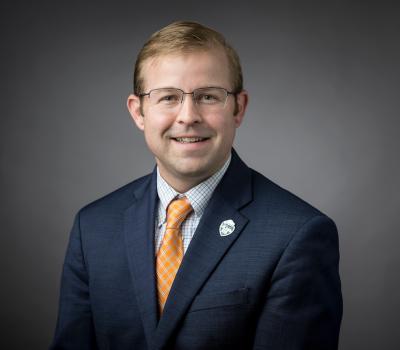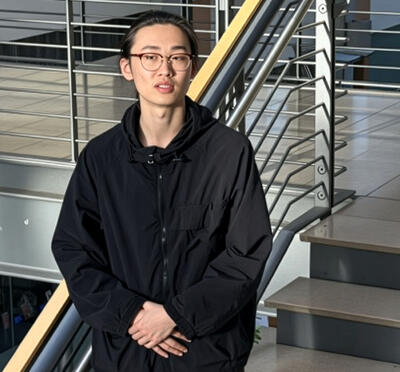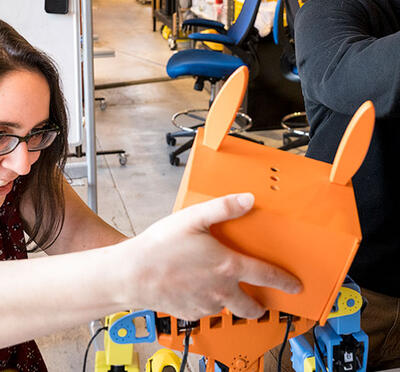When Hank (’50 B.S., Mechanical Engineering, ’01 Engineering Hall of Fame) and Janice Schuette established the School of Nuclear Science and Engineering’s first endowed chair, they created a legacy that continues to help NSE faculty make lasting impacts in the field.
Although Oregon State University did not yet offer a degree in nuclear engineering when Hank Schuette was a student, he was throughout his life a passionate proponent of nuclear energy.
“Because future energy demands might very well be met by nuclear power, I’ve always thought it was an area we should be working on, a field where we should be ahead of the curve,” he once said.
The couple’s $3 million gift created the Henry W. and Janice J. Schuette Endowed Chair in Nuclear Engineering and Radiation Health Physics in 2003.
Professor Emeritus José Reyes held the chair until he retired from Oregon State in 2018. The endowment enabled Reyes to work on his research to develop safer, small modular nuclear reactors, which led to his co-founding NuScale Power in 2007. The Nuclear Regulatory Commission is scheduled to complete its review of NuScale’s design in 2020, and the company is on target to deploy its first plant by 2026.
“Our mission at NuScale is to improve the quality of life for people around the world by providing clean energy and water,” Reyes said. “The Schuette endowment started me on a remarkable journey. The result will benefit many generations to come.”
In addition to the endowed chair, the Henry W. and Janice J. Schuette Professorship in Nuclear Science and Engineering was established through the couple’s estate after Hank’s death in 2013. Brian Woods, professor of nuclear science and engineering, was first to hold this professorship. The Schuette Professorship allowed Woods to create a class in plasma physics, which he will continue to teach every year as an elective for undergraduate and graduate students.
Following Reyes’ retirement, Woods assumed the endowed chair title, and the professorship was given to Wade Marcum (’10 Ph.D., Nuclear Engineering), associate school head and professor of nuclear engineering.
The endowment has enabled Woods to carve out time to pivot his research focus a bit, from fluid mechanics and heat transfer to plasma physics. He has already hired one graduate student for this work and is looking to hire a second.
“The interesting part of plasma physics is that it’s like fluid mechanics or fluid dynamics, but it has added complexity,” Woods said. “So I’m not really leaving what I’m already working on, but just taking it into a different type of a problem.
The Schuette Chair is going to help me get the time that I need to bootstrap a research program in plasma physics.”
Marcum says the Schuette Professorship has motivated him to take on greater challenges.
“I look at it as a reassurance that I’ve been doing the right things, and hopefully I can continue to step up and accomplish even more, because this facilitates other opportunities,” Marcum said.
One of the things he’s been doing right is leading his research group in experimental thermal hydraulics, studying heat transfer and fluid flow as it applies to nuclear reactors. His group focuses on specific problems within reactors and performs experiments to understand the mechanics and then develop solutions to ultimately create safer nuclear reactors.
Marcum’s research hones in on flow-induced vibration, one of the most common failure mechanisms in nuclear reactors. In an operating reactor, vibrating parts can come into contact with each other — the resulting wear is called fretting — creating stress points that can weaken those parts and eventually cause them to fail.
A second area of focus for Marcum is the phenomenon of power excursion. (“The effects of a power surge and the safety concerns in reactors are pretty well understood, but how they happen and when they happen aren’t,” he said.) In addition, Marcum’s group performs experiments to understand what happens to the fuel that escapes the system in the event of a failure.
The Schuettes’ generous gifts have undoubtedly helped put Oregon State “ahead of the curve” in nuclear engineering, and they continue to help push Hank Schuette’s alma mater to greater heights into the future.
Sidebar: Connections
While the Schuettes’ gifts to the School of Nuclear Science and Engineering and the selection of the deserving faculty named to the endowed positions were very intentional, a series of happenstances connect the Schuettes, José Reyes, Brian Woods, and Wade Marcum, making the Schuettes’ legacy especially serendipitous.
- Both Hank Schuette and Brian Woods served in the U.S. Navy, Schuette during World War II on a minesweeper, and Woods in the 1990s on a mine countermeasure ship. (“We ended up spending a half hour just talking about our Navy experiences, which were relatively similar, but in much different eras,” Woods said.)
- Woods went to graduate school at the University of Maryland, as did Reyes. Although they did not know each other then, both worked on the same research project — Reyes when it was beginning, and Woods when the project ended. The two didn’t meet until Woods came to Oregon State to interview for a job.
- Not so coincidently, Woods was Marcum’s graduate advisor at Oregon State. Woods convinced Marcum that Oregon State was an excellent place to establish a career in academia in nuclear engineering. Woods says when he was in graduate school, he never thought about coming west to Oregon State to start his career, but that after his interview for his current job, he couldn’t think of being anywhere else.





